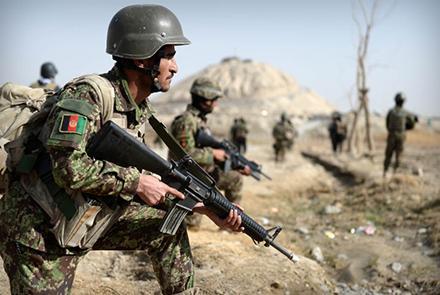The Special Inspector General for Afghanistan Reconstruction (SIGAR) on Thursday presented its 41st quarterly report on the status of reconstruction in Afghanistan to the US Congress in which it said that the Afghan government’s control and influence of districts is at lowest level (55.5%) since the institution began tracking in November 2015.
SIGAR also stated in its report that the Afghan National Defense and Security Forces (ANDSF) had 312,328 personnel in July 2018 (not including civilians), down 1,914 personnel since last quarter and down 8,827 personnel since the same period last year.
The report said the Afghan government controls or has influence over 55.5 percent of the country’s districts, down half a percentage point from the previous three-month period and 16 percentage points since November 2015.
The report said Afghan forces “made minimal or no progress in pressuring the Taliban over the quarter” and “failed to gain greater control or influence over districts, population and territory this quarter”.
The report highlighted several “discouraging developments” over the past few months, including the Taliban’s rejection of a second ceasefire and its five-day siege on Ghazni. The report also cited last month’s attack in Kandahar that killed the regional police and intelligence chief. The US and NATO forces Commander Gen. Austin S. Miller was present at the attack, but was unharmed.
The districts that the Afghan government controls or influences represent about 65 percent of the country’s population, SIGAR said.
SIGAR said that insurgent control of districts also decreased over the last quarter, but added that contested districts under neither government nor insurgent control has increased.
The report pointed to a high number of casualties among Afghan forces. While the exact figures are classified, the report said casualties from May 1 to Oct. 1 are “the greatest it has ever been during like periods.”
This comes after the US Defense Secretary James Mattis said Tuesday that Afghan forces suffered 1,000 casualties in August and September.
US officials have insisted that US President Trump’s strategy, announced in August 2017, is working. They have cited signs that the Taliban is more open to negotiations to end the war, even as violence escalates. The administration’s special envoy for Afghanistan’s peace, Zalmay Khalilzad, met with the Taliban officials last month in Qatar.
Miller said Wednesday that he has changed the approach to fighting the Taliban to be a more “offensive mindset”.
“My assessment is the Taliban also realizes they cannot win militarily,” he said. “So if you realize you can't win militarily at some point, fighting is just, people start asking why. So you do not necessarily wait us out, but I think now is the time to start working through the political piece of this conflict.”
Meanwhile, SIGAR reported the opium economic impact in Afghanistan has ballooned and UNODC estimates in 2017 the poppy crop generated about $1.4 billion for farmers, plus billions more for refiners and traffickers making the total value of the 2017 opium production at $4.1 to $6.6 billion.
The inspector general expressed concern that the United States is doing little to address Afghanistan’s opium trade, which is used to fund the insurgency and is the main source of heroin in Europe and Canada.
“Despite its importance … counternarcotics seems to have fallen completely off the US agenda,” special inspector general John Sopko wrote in the report’s introduction. “The State Department’s new ‘Integrated Country Strategy’ for Afghanistan no longer includes counternarcotics as a priority, but instead apparently subsumes the issue into general operations there.”
Sopko said the US military also said it has no counternarcotics mission, while the US Agency for International Development said it has no plans to address poppy cultivation.
The report said that from 2002 through September 2018, the United States has committed an average of more than $1.5 million a day to help the Afghan government combat narcotics. As of September 30, 2018, US counternarcotics-related appropriations for that purpose had reached $8.88 billion.
“Tragically, opium cultivation alone—i.e., not counting processing, transporting, or marketing it—may provide the equivalent of up to 590,000 full-time jobs.8 That number greatly exceeds the 352,000 target strength of Afghanistan’s army and police forces,” the report said.
“The monetary proceeds of the Afghan opium sector are a major source of income to farmers in the desperately poor country, but the cash flow also fills the purses of the Taliban insurgents who continue in their efforts to topple the internationally recognized government based in Kabul,” the report said.
The report added that in February of this year, Deputy Secretary of State John Sullivan told the Senate Foreign Relations Committee that some 65% of Taliban revenues are derived from narcotics. The Department of Defense (DOD) noted this year that “it’s plausible the Taliban now place greater emphasis on narcotics as a primary source of revenue” than previously, but opinions vary on the extent of narcotics revenue owing to the insurgency.
Click here for full SIGAR report.


